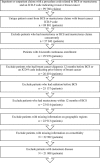Factors contributing to underuse of radiation among younger women with breast cancer
- PMID: 24317177
- PMCID: PMC3937848
- DOI: 10.1093/jnci/djt340
Factors contributing to underuse of radiation among younger women with breast cancer
Abstract
Background: Evidence-based literature has confirmed the effectiveness of radiation therapy (RT) after breast-conserving surgery (BCS), especially for young women. However, women with young children may be less likely to be compliant. This study explores factors associated with noncompliance of RT among insured young patients.
Method: Using the MarketScan Database, we identified the study cohort as women aged 20 to 64 years who had a BCS between January 1, 2004, and December 31, 2009, and had continuous enrollment 12 months before and after the date of BCS. Patients who had any radiation claims within a year of BCS were considered compliant. Adjusted odds of compliance were estimated from logistic regressions for the full sample and age-stratified subgroups. Sensitivity analyses were performed to evaluate the robustness of study findings. All statistical tests were two-sided.
Results: Eighteen thousand one hundred twenty of 21 008 (86.25%) nonmetastatic BCS patients received RT. Among patients aged 20 to 64 years, those with children aged 7 to 12 years, those with children aged 13 to 17 years, and those with no children or children aged 18 years or older were more likely to receive RT than patients with at least one child aged less than 7 years (7-12 years: odds ratio (OR) = 1.32, 95% confidence interval (CI) = 1.05 to 1.66, P = .02; 13-17 years: OR = 1.41, 95% CI = 1.13 to 1.75, P = .002; no children or ≥18 years: OR = 1.38, 95% CI = 1.13 to 1.68, P = .001). Stratified analyses showed that the above association was primarily driven by women in the youngest age group (aged 20-50). Other important factors included breast cancer quality of care measures, enrollment in health maintenance organizations or capitated preferred provider organizations, travelled to a Census division outside their residence for BCS, and whether patients were primary holders of the insurance policy.
Conclusions: Competing demands from child care can constitute a barrier to complete guideline-concordant breast cancer therapy. Younger patients may be confronted by unique challenges that warrant more attention in future research.
Figures


References
-
- Clarke M, Collins R, Darby S, et al. Effects of radiotherapy and of differences in the extent of surgery for early breast cancer on local recurrence and 15-year survival: an overview of the randomised trials. Lancet. 2005;366(9503):2087–2106 - PubMed
-
- Desch CE, McNiff KK, Schneider EC, et al. American Society of Clinical Oncology/National Comprehensive Cancer Network Quality Measures. J Clin Oncol. 2008;26(21):3631–3637 - PubMed
-
- Haggstrom DA, Quale C, Smith-Bindman R. Differences in the quality of breast cancer care among vulnerable populations. Cancer. 2005;104(11):2347–2358 - PubMed
-
- Smith BD, Gross CP, Smith GL, Galusha DH, Bekelman JE, Haffty BG. Effectiveness of radiation therapy for older women with early breast cancer. J Natl Cancer Inst. 2006;98(10):681–690 - PubMed
Publication types
MeSH terms
Grants and funding
LinkOut - more resources
Full Text Sources
Other Literature Sources
Medical

